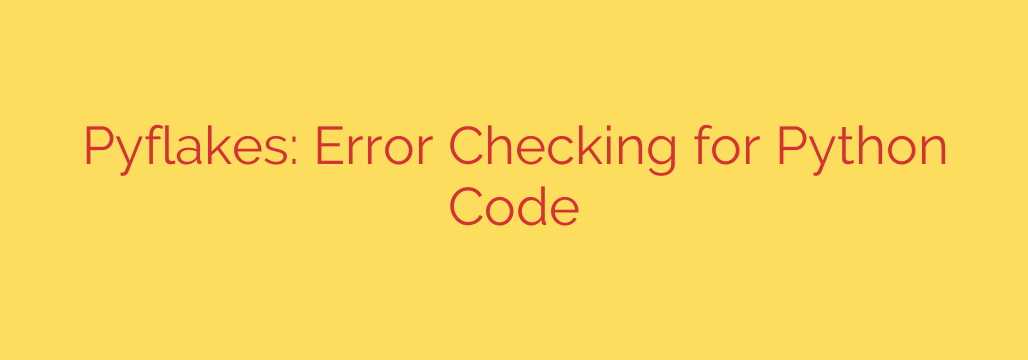
Improve Your Python Code with Pyflakes: A Guide to Effortless Error Checking
Writing clean, bug-free Python code is a top priority for every developer. While Python is known for its readability, it’s a dynamically typed language, which means many common errors aren’t caught until you run your program. This can lead to frustrating debugging sessions and unexpected runtime failures. Fortunately, static analysis tools can help you catch these issues before they become a problem.
Enter Pyflakes, a simple yet powerful tool designed to check your Python code for errors without ever executing it. If you’re looking for a fast, no-fuss way to improve your code quality, Pyflakes might be the perfect addition to your toolkit.
What Exactly is Pyflakes?
Pyflakes is a static analysis tool that scans Python source files for logical errors. Unlike more complex linters, its primary mission is to find mistakes and potential bugs, not to enforce stylistic conventions. It operates by parsing your code and analyzing the abstract syntax tree (AST), allowing it to identify issues with a high degree of accuracy and incredible speed.
The core philosophy of Pyflakes is to generate zero false positives. This means when Pyflakes reports an error, you can be confident that it’s a legitimate issue worth fixing. This focus on correctness over opinionated style makes it an unobtrusive and highly valuable utility.
Why Choose Pyflakes? Key Advantages
While there are many code analysis tools available, Pyflakes stands out for several reasons:
- Lightning Fast: Because it doesn’t check for style or perform overly complex analysis, Pyflakes runs almost instantly, making it perfect for running frequently during development.
- Focused on Errors: Its main goal is to find logical bugs. It excels at catching common mistakes like undefined variables, unused imports, and references to variables before assignment.
- Simple and Unobtrusive: Pyflakes has a narrow scope. It won’t complain about line length, whitespace, or other PEP 8 style guidelines. This “low noise” approach means you only get alerted to things that are likely actual bugs.
- Easy to Integrate: You can run Pyflakes from the command line, integrate it into your favorite code editor (like VS Code, Sublime Text, or Vim), or add it to your CI/CD pipeline with minimal effort.
Pyflakes vs. Other Tools: Pylint and Flake8
It’s important to understand where Pyflakes fits in the ecosystem of Python linters.
- Pylint: This is a much more comprehensive and opinionated linter. Pylint checks for logical errors, enforces a coding standard (like PEP 8), looks for code smells, and offers detailed statistics about your codebase. It’s powerful but can be “noisy” and requires more configuration.
- Flake8: This tool provides a great middle ground. In fact, Flake8 is a wrapper that intelligently combines Pyflakes with
pycodestyle(for style checking) and a McCabe complexity checker. If you want the error-checking power of Pyflakes plus style enforcement, Flake8 is an excellent choice. If you only want to catch logical errors and prefer to handle code style separately, using Pyflakes directly is the ideal solution.
Getting Started: How to Install and Use Pyflakes
One of the best things about Pyflakes is how easy it is to get up and running.
Installation
You can install Pyflakes directly from the Python Package Index (PyPI) using pip. Open your terminal or command prompt and run:
pip install pyflakes
That’s it! Pyflakes is now installed in your Python environment.
Basic Usage
To check a single file, simply run Pyflakes from your terminal and provide the file name:
pyflakes your_script.py
To check all Python files within a project directory and its subdirectories, just point it at the directory:
pyflakes your_project_directory/
If there are no errors, Pyflakes will output nothing. If it finds issues, it will print clear, concise messages indicating the file, line number, and a description of the error.
Common Errors Pyflakes Will Catch for You
Here are a few examples of common programming mistakes that Pyflakes instantly identifies.
1. Unused Imports
You import a module but never use it in your code. This adds unnecessary clutter and can confuse other developers.
Code:
import math import os # This module is never used def calculate_area(radius): return math.pi * radius ** 2Pyflakes Output:
your_script.py:2:1 'os' imported but unused
2. Undefined Variables
You try to use a variable that hasn’t been assigned a value yet, which would cause a NameError at runtime.
- Code:
python
def get_greeting(name):
return f"Hello, {naem}" # Typo: 'naem' instead of 'name'
- Pyflakes Output:
your_script.py:2:24 undefined name 'naem'
3. Redefined Functions or Variables
You accidentally redefine a function or variable within the same scope, which can lead to unexpected behavior.
Code:
def my_function(): print("First definition") # ... some code ... def my_function(): print("Second definition")Pyflakes Output:
your_script.py:6:1 redefinition of unused 'my_function' from line 1
A Smarter Way to Write Python
Integrating a tool like Pyflakes into your regular development workflow is a small change that pays huge dividends. It acts as an automated proofreader for your code, catching simple but costly mistakes before they ever make it into production.
By focusing purely on logical errors with speed and accuracy, Pyflakes helps you write more robust and reliable Python code. Whether you use it on its own for its simplicity or as part of a larger toolchain with Flake8, adopting Pyflakes is a crucial step toward becoming a more effective and efficient developer.
Source: https://www.linuxlinks.com/pyflakes-checks-python-source-files-errors/








